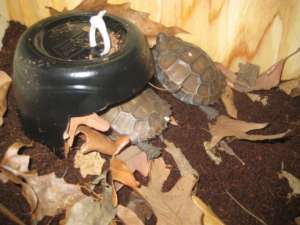Resources and Social Structures in Juvenile Tortoises
A couple months ago, we posted a Research Blog outlining Zoo Atlanta’s longtime research partnerships with local universities. These partnerships have led to a number of fruitful discoveries and publications. We’re excited to start sharing a bit of this work.
In today’s blog, we’ll be looking at how resources affect social behavior in juvenile tortoises! Students from our Georgia Tech partnership (Aerin DeRussy, Kimberly Hurst, Kristine Schaffer, Zhichao Pu and faculty member Dr. Linda Green) published the original article, “Social behaviour in the context of a limited resource in juvenile tortoises (Manouria emys)” in Herpetological Journal with Zoo Atlanta Director of Research, Dr. Joseph Mendelson. Although appearing a few years back in 2013, we’re sure many of our tortoise fans will continue to find the findings fascinating!
Background:
This study built on former findings demonstrating that adult tortoises exhibit different social behaviors, including behaviors meant to show dominance. This has been observed mainly among males. Dominant males tend be larger (although not always), have more mates, and occupy burrows more frequently (burrows are important for some species of tortoises as they serve as refuge from both predators and daytime heat and provide proper humid conditions). Relevant social information is often communicated between tortoises using chemical cues but disputes over burrows can lead to visual “threat” signals and sometimes minor tussles between individuals.
Intervention:
The Zoo Atlanta study differs from such previous work in its focus on juvenile tortoises (as opposed to adults). This opens new lines of inquiry, as reproductive success is likely to be a major factor in dominant behaviors in adults but does not concern juveniles. Rather, this study sought to assess if social structures exist in juvenile tortoises, using the context of limited shelter availability. The specific species observed was the Burmese mountain tortoise (Manouria emys).
Method: 
The study was conducted in full at Zoo Atlanta. The tortoises were maintained at the same temperature and humidity, and observed in three pairings:
- one shelter and one tortoise
- one shelter and three tortoises
- two shelters and three tortoises
The shelters in question were made from 32-ounce round plastic food containers. Black spray paint was applied to the outside of the containers to create a darkened environment within, and an entrance was cut on one side of the container. Each shelter was only large enough to house one tortoise. Researchers counted the total number of times that individual tortoises occupied a shelter to give each tortoise an overall occupancy rate.
Findings:
The study suggests a social structure among juvenile tortoises in that when not grouped with other tortoises, a single tortoise was rarely found in a shelter. However, when other tortoises were present, the animals frequently used the shelters. This implies the shelters became more desirable in a social situation. Although the study did not find a definite reason for this, researchers hypothesized the tortoises may have been demonstrating resource guarding.
As with adult tortoises, this study found that heavier tortoises occupied the shelters more frequently, signifying dominance. However, unlike adult tortoises, there was no indication that gender, or even size, had any effect. This led researchers to hypothesize that perhaps gender effects develop with reproductive maturity.
Ramifications and areas for further study:
Burmese mountain tortoises are classified as endangered due to habitat destruction and harvesting for medicinal or food use. Consequently, studying their social behavior in institutions such as accredited zoos is important for conservation purposes, providing insight that can be useful to maintaining these populations in the wild.
As such, this study has important implications both for maintaining juvenile tortoises in breeding programs and out in the wild, suggesting that competition for shelters may occur in situations where individuals are housed in groups. Whereas this study involved fewer shelters than tortoises, future work could explore how multiple shelters could decrease social competition.
We hope you enjoyed this glimpse into the fascinating research happening at Zoo Atlanta! Be sure to check out the full article, and keep an eye out for similar upcoming pieces.

Connect With Your Wild Side #onlyzooatl